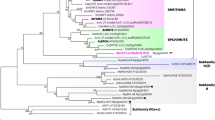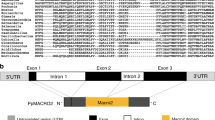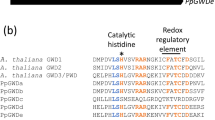Abstract
Stomata are microscopic valves on plant surfaces that originated over 400 million years (Myr) ago and facilitated the greening of Earth's continents by permitting efficient shoot–atmosphere gas exchange and plant hydration1. However, the core genetic machinery regulating stomatal development in non-vascular land plants is poorly understood2–4 and their function has remained a matter of debate for a century5. Here, we show that genes encoding the two basic helix–loop–helix proteins PpSMF1 (SPEECH, MUTE and FAMA-like) and PpSCREAM1 (SCRM1) in the moss Physcomitrella patens are orthologous to transcriptional regulators of stomatal development in the flowering plant Arabidopsis thaliana and essential for stomata formation in moss. Targeted P. patens knockout mutants lacking either PpSMF1 or PpSCRM1 develop gametophytes indistinguishable from wild-type plants but mutant sporophytes lack stomata. Protein–protein interaction assays reveal heterodimerization between PpSMF1 and PpSCRM1, which, together with moss–angiosperm gene complementations6, suggests deep functional conservation of the heterodimeric SMF1 and SCRM1 unit is required to activate transcription for moss stomatal development, as in A. thaliana7. Moreover, stomata-less sporophytes of ΔPpSMF1 and ΔPpSCRM1 mutants exhibited delayed dehiscence, implying stomata might have promoted dehiscence in the first complex land-plant sporophytes.
This is a preview of subscription content, access via your institution
Access options
Subscribe to this journal
Receive 12 digital issues and online access to articles
$119.00 per year
only $9.92 per issue
Buy this article
- Purchase on Springer Link
- Instant access to full article PDF
Prices may be subject to local taxes which are calculated during checkout




Similar content being viewed by others
References
Berry, J. A., Beerling, D. J. & Franks, P. J. Stomata: key players in the earth system, past and present. Curr. Opin. Plant Biol. 13, 232–239 (2010).
Chater, C., Gray, J. E. & Beerling, D. J. Early evolutionary acquisition of stomatal control and development gene signalling networks. Curr. Opin. Plant Biol. 16, 638–646 (2013).
Vatén, A. & Bergmann, D. C. Mechanisms of stomatal development: an evolutionary view. Evodevo 3, 11 (2012).
Pressel, S., Goral, T. & Duckett, J. G. Stomatal differentiation and abnormal stomata in hornworts. J. Bryol. 36, 87–103 (2014).
Haberlandt, G. Physiologische Pflanzenanatomie 5th edn (Engelmann, 1918).
MacAlister, C. A. & Bergmann, D. C. Sequence and function of basic helix-loop-helix proteins required for stomatal development in Arabidopsis are deeply conserved in land plants. Evol. Dev. 13, 182–192 (2011).
Kanaoka, M. M. et al. SCREAM/ICE1 and SCREAM2 specify three cell-state transitional steps leading to Arabidopsis stomatal differentiation. Plant Cell 20, 1775–1785 (2008).
Beerling, D. J. The Emerald Planet: How Plants Changed Earth's History (Oxford Univ. Press, 2007).
Edwards, D., Kerp, H. & Hass, H. Stomata in early land plants: an anatomical and ecophysiological approach. J. Exp. Bot. 49, 255–278 (1998).
Menand, B. et al. An ancient mechanism controls the development of cells with a rooting function in land plants. Science 316, 1477–1480 (2007).
Tam, T. H. Y., Catarino, B. & Dolan, L. Conserved regulatory mechanism controls the development of cells with rooting functions in land plants. Proc. Natl Acad. Sci. USA 112, E3959–E3968 (2015).
Harrison, C. J. et al. Independent recruitment of a conserved developmental mechanism during leaf evolution. Nature 434, 509–514 (2005).
Sakakibara, K., Nishiyama, T., Deguchi, H. & Hasebe, M. Class 1 KNOX genes are not involved in shoot development in the moss Physcomitrella patens but do function in sporophyte development. Evol. Dev. 10, 555–566 (2008).
Horst, N. A. et al. A single homeobox gene triggers phase transition, embryogenesis and asexual reproduction. Nat. Plants 2, 15209 (2016).
Raven, J. A. Selection pressures on stomatal evolution. New Phytol. 153, 371–386 (2002).
MacAlister, C. A., Ohashi-Ito, K. & Bergmann, D. C. Transcription factor control of asymmetric cell divisions that establish the stomatal lineage. Nature 445, 537–540 (2007).
Chinnusamy, V. et al. ICE1: a regulator of cold-induced transcriptome and freezing tolerance in Arabidopsis. Genes Dev. 17, 1043–1054 (2003).
Olsen, J. L. et al. The genome of the seagrass Zostera marina reveals angiosperm adaptation to the sea. Nature 530, 331–335 (2016).
Ran, J.-H., Shen, T.-T., Liu, W.-J. & Wang, X.-Q. Evolution of the bHLH genes involved in stomatal development: implications for the expansion of developmental complexity of stomata in land plants. PLoS ONE 8, e78997 (2013).
O'Donoghue, M. T. et al. Genome-wide transcriptomic analysis of the sporophyte of the moss Physcomitrella patens. J. Exp. Bot. 64, 3567–3581 (2013).
Ortiz-Ramirez, C. et al. A transcriptome atlas of Physcomitrella patens provides insights into the evolution and development of land plants. Mol. Plant 9, 205–220 (2016).
Sack, F. D. & Paolillo, D. J. Incomplete cytokinesis in Funaria stomata. Am. J. Bot. 72, 1325–1333 (1985).
Weinthal, D. & Tzfira, T. Imaging protein-protein interactions in plant cells by bimolecular fluorescence complementation assay. Trends Plant Sci. 14, 59–63 (2009).
Ito, T. et al. A comprehensive two-hybrid analysis to explore the yeast protein interactome. Proc. Natl Acad. Sci. USA 98, 4569–4574 (2001).
Haig, D. Filial mistletoes: the functional morphology of moss sporophytes. Ann. Bot. 111, 337–345 (2013).
Merced, A. & Renzaglia, K. S. Moss stomata in highly elaborated Oedipodium (Oedipodiaceae) and highly reduced Ephemerum (Pottiaceae) sporophytes are remarkably similar. Am. J. Bot. 100, 2318–2327 (2013).
Chater, C. et al. Regulatory mechanism controlling stomatal behavior conserved across 400 million years of land plant evolution. Curr. Biol. 21, 1025–1029 (2011).
Garner, D. L. B. & Paolillo, D. J. J. On the functioning of stomates in Funaria. Bryologist 76, 423–427 (1973).
Merced, A. & Renzaglia, K. S. Patterning of stomata in the moss Funaria: a simple way to space guard cells. Ann. Bot. 117, 985–994 (2016).
Lind, C. et al. Stomatal guard cells co-opted an ancient ABA-dependent desiccation survival system to regulate stomatal closure. Curr. Biol. 25, 928–935 (2015).
Franks, P. J. & Beerling, D. J. Maximum leaf conductance driven by CO2 effects on stomatal size and density over geologic time. Proc. Natl Acad. Sci. USA 106, 10343–10347 (2009).
Rensing, S. A. et al. The Physcomitrella genome reveals evolutionary insights into the conquest of land by plants. Science 319, 64–69 (2008).
Cove, D. The moss, Physcomitrella patens. J. Plant Growth Regul. 19, 275–283 (2000).
Wallace, S. et al. Conservation of Male Sterility 2 function during spore and pollen wall development supports an evolutionarily early recruitment of a core component in the sporopollenin biosynthetic pathway. New Phytol. 205, 390–401 (2015).
Reski, R. & Abel, W. O. Induction of budding on choloronemata and caulonemata of the moss, Physcomitrella patens, using isopentenyladenine. Planta 165, 354–358 (1985).
Egener, T. et al. High frequency of phenotypic deviations in Physcomitrella patens plants transformed with a gene-disruption library. BMC Plant Biol. 2, 6 (2002).
Frank, W., Ratnadewi, D. & Reski, R. Physcomitrella patens is highly tolerant against drought, salt and osmotic stress. Planta 220, 384–394 (2005).
Hohe, A., Rensing, S. A., Mildner, M., Lang, D. & Reski, R. Day length and temperature strongly influence sexual reproduction and expression of a novel MADS-box gene in the moss Physcomitrella patens. Plant Biol. 4, 595–602 (2002).
Hohe, A. et al. An improved and highly standardised transformation procedure allows efficient production of single and multiple targeted gene-knockouts in a moss, Physcomitrella patens. Curr. Genet. 44, 339–347 (2004).
Kamisugi, Y., Cuming, A. C. & Cove, D. J. Parameters determining the efficiency of gene targeting in the moss Physcomitrella patens. Nucleic Acids Res. 33, 10 (2005).
Luna, E. et al. Plant perception of β-aminobutyric acid is mediated by an aspartyl-tRNA synthetase. Nat. Chem. Biol. 10, 450–456 (2014).
Acknowledgements
We thank R. Haas and T. Fulton for excellent technical assistance. R.S.C. was supported by a NERC studentship. D.C.B is a GBMF investigator of the Howard Hughes Medical Institute. D.J.B. acknowledges funding through an ERC Advanced Grant (CDREG, 322998). R.R. acknowledges funding through the Excellence Initiative of the German Federal and States Governments (EXC294). A.C.C. and Y.K. acknowledge support from BBSRC (Grant numbers BB/F001797/1 and BB/I006710/1).
Author information
Authors and Affiliations
Contributions
C.C.C., R.S.C., W.F., J.E.G., A.F., D.J.B. and R.R. designed the study, C.C.C., R.S.C., D.L. and M.T. undertook the experiments with contributions from S.W., Y.K. and A.C.C., C.A.M., S.C., D.C.B., D.L., E.L.D and W.F. contributed materials and advice. A.C.C. constructed vectors for moss targeted knockout (SMF1 and SMF2), Y.K. carried out moss transformation (SMF2-KO) and yeast two-hybrid analysis, A.C.C. and Y.K. carried out Southern blot hybridization of the knockout mutant lines. D.J.B., R.R, C.C.C. and R.S.C. wrote the paper with contributions from D.C.B. All authors read, commented on and approved the final version of the manuscript.
Corresponding authors
Ethics declarations
Competing interests
The authors declare no competing financial interests.
Supplementary information
Supplementary Information
Supplementary Figures 1–15, Supplementary Methods, Supplementary Discussion, Supplementary Tables 1 and 2, Supplementary References, Supplementary Data Files 1–4. (PDF 3050 kb)
Supplementary Data 1
Supplementary Dataset 1. (TXT 225 kb)
Supplementary Data 2
Supplementary Dataset 2. (TXT 174 kb)
Supplementary Data 3
Supplementary Dataset 3. (TXT 243 kb)
Supplementary Data 4
Supplementary Dataset 4. (TXT 95 kb)
Rights and permissions
About this article
Cite this article
Chater, C., Caine, R., Tomek, M. et al. Origin and function of stomata in the moss Physcomitrella patens. Nature Plants 2, 16179 (2016). https://doi.org/10.1038/nplants.2016.179
Received:
Accepted:
Published:
DOI: https://doi.org/10.1038/nplants.2016.179
This article is cited by
-
Stomatal regulators are co-opted for seta development in the astomatous liverwort Marchantia polymorpha
Nature Plants (2023)
-
Integrating stomatal physiology and morphology: evolution of stomatal control and development of future crops
Oecologia (2021)
-
Functional redundancy and divergence of β-carbonic anhydrases in Physcomitrella patens
Planta (2020)
-
Heterologous expression of the metallothionein PpMT2 gene from Physcomitrella patens confers enhanced tolerance to heavy metal stress on transgenic Arabidopsis plants
Plant Growth Regulation (2020)
-
Agrobacterium-mediated Tnt1 mutagenesis of moss protonemal filaments and generation of stable mutants with impaired gametophyte
Molecular Genetics and Genomics (2019)



